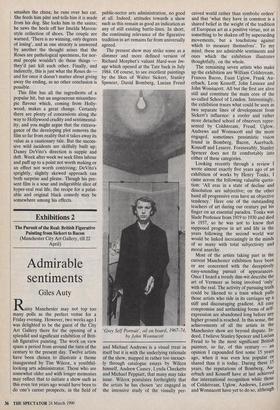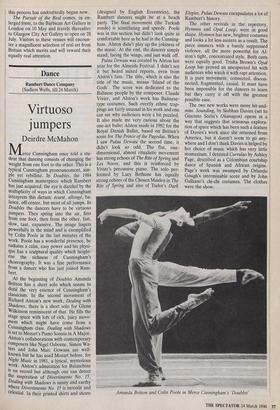Exhibitions 2
Admirable sentiments
Giles Auty
rainy Manchester may not top too many polls as the perfect venue for a Friday evening. However, two weeks ago I was delighted to be the guest of the City Art Gallery there for the opening of a splendid and significant exhibition of Brit- ish figurative painting. The work on view spans a period from around the turn of the century to the present day. Twelve artists have been chosen to illustrate a theme inaugurated by Tim Wilcox, a youthful- looking arts administrator. Those who are somewhat older and with longer memories may reflect that to initiate a show such as this even ten years ago would have been to do one's career prospects, in the field of public-sector arts administration, no good at all. Indeed, attitudes towards a show such as this remain as good an indication as any of still existing battle-lines. In short, the continuing relevance of the figurative tradition in art remains far from universally agreed.
The present show may strike some as a slimmer and more defined version of Richard Morphet's valiant Hard-won Im- age which opened at the Tate back in July 1984. Of course, to see excellent paintings by the likes of Walter Sickert, Stanley Spencer, David Bomberg, Lucian Freud
`Grey Self Portrait', oil on board, 1967-74, by John Wonnacott and Michael Andrews is a visual treat in itself but it is with the underlying rationale of the show, mapped in rather too inexact- ly through catalogue essays by Wilcox himself, Andrew Causey, Lynda Checketts and Michael Peppiatt, that many may take issue. Wilcox postulates forthrightly that the artists he has chosen 'are engaged in the intensive study of the visually per- ceived world rather than symbolic orders' and that 'what they have in common is a shared belief in the weight of the tradition of European art as a positive virtue, not as something to be shaken off by superseding movements, but a touchstone against which to measure themselves'. To my mind, these are admirable sentiments and ones which the exhibition illustrates thoughtfully, on the whole.
The remaining seven artists who make up the exhibition are William Coldstream, Frances Bacon, Euan Uglow, Frank Au- erbach, Leon Kossoff, John Lessore and John Wonnacott. All but the first are alive still and constitute the main core of the so-called School of London. Interestingly, the exhibition traces what could be seen as two separate lines of development from Sickert's influence: a cooler and rather more detached school of observers repre- sented by Coldstream, Freud, Uglow, Andrews and Wonnacott and the more engaged, sometimes pessimistic vision found in Bomberg, Bacon, Auerbach, Kossoff and Lessore. Foreseeably, Stanley Spencer does not fit comfortably into either of these categories.
Looking recently through a review I wrote almost exactly five years ago of an exhibition of works by Henry Tonks, I came across the following valuable quota- tion: 'All eras in a state of decline and dissolution are subjective; on the other hand all progressive eras have an objective tendency.' Here one of the outstanding teachers of art during our century put his finger on an essential paradox. Tonks was Slade Professor from 1919 to 1930 and died in 1937, so he was not to know that supposed progress in art and life in the years following the second world war would be linked increasingly in the minds of so many with total subjectivity and moral anarchy.
Most of the artists taking part in the current Manchester exhibition have been or are concerned with the deceptively easy-sounding pursuit of appearances. Once I heard a trendy dim-wit describe the art of Vermeer as being involved 'only' with the real. The activity of pursuing truth could be likened to a train which pulls those artists who ride in its carriages up a stiff and discouraging gradient. All easy compromise and unthinking forms of self- expression are abandoned long before any higher ground is reached. In this sense, the achievements of all the artists in the Manchester show are beyond dispute. In- deed, I believe Stanley Spencer and Lucian Freud to be the most significant British painters, so far, of this century — an opinion I expounded first some 15 years ago, when it was even less popular or shared than it is today. During these 15 years, the reputations of Bomberg, Au- erbach and Kossoff have at last achieved due international recognition while those of Coldstream, Uglow, Andrews, Lessore and Wonnacott have yet to do so, although this process has undoubtedly begun now.
The Pursuit of the Real comes, in en- larged form, to the Barbican Art Gallery in London on 10 May and travels thereafter to Glasgow City Art Gallery to open on 28 July. Visitors to these venues will encoun- ter a magnificent selection of real art from Britain which merits and will reward their equally real attention.



















































 Previous page
Previous page